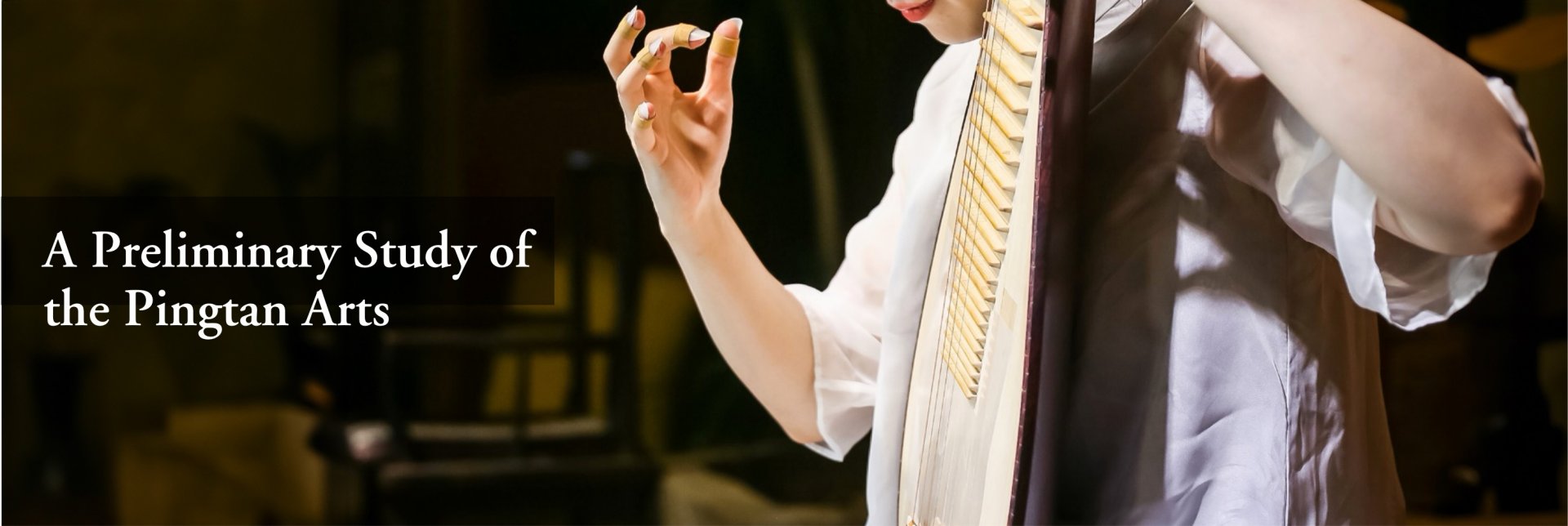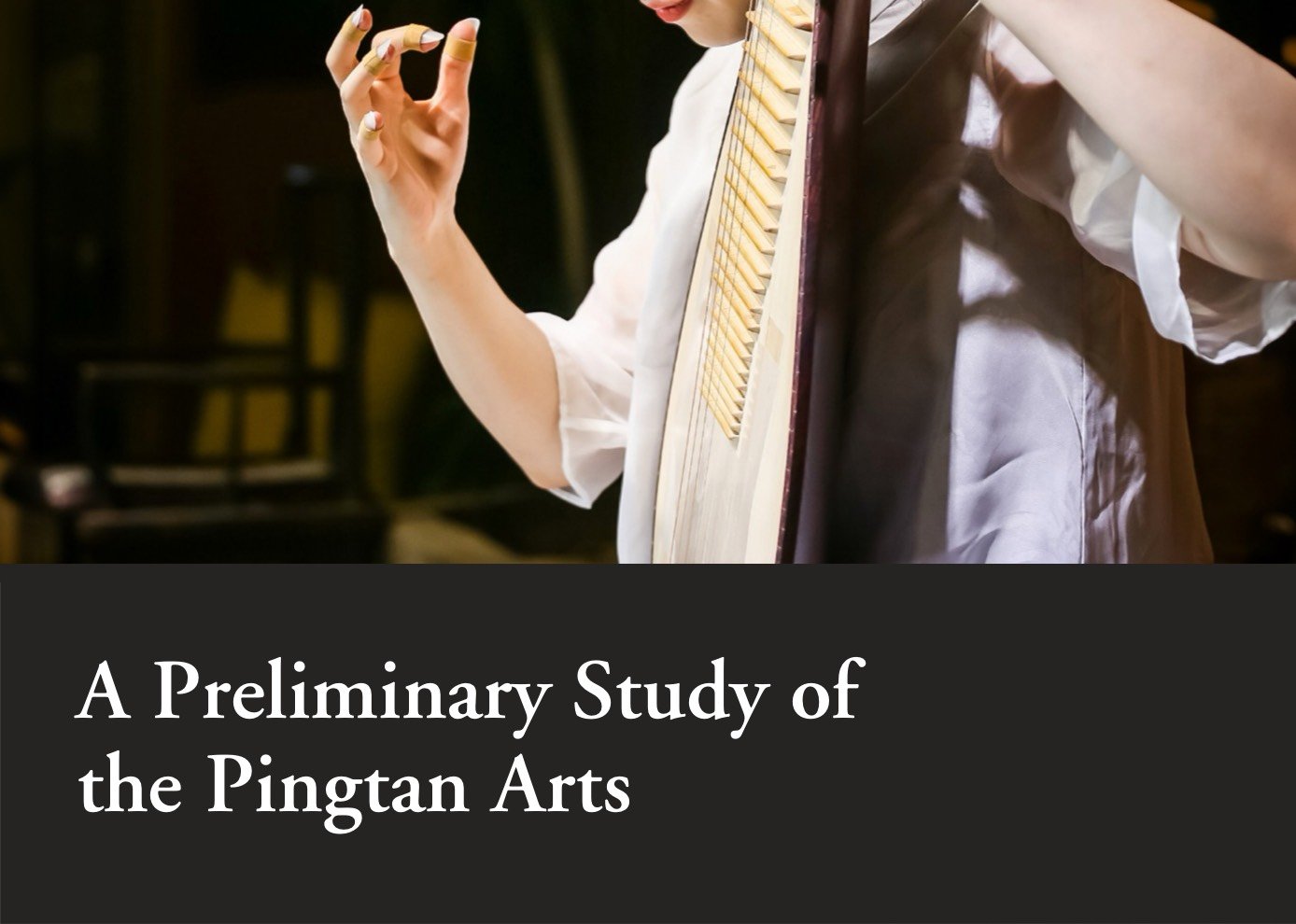A Preliminary Study of the Pingtan Arts
Pingtan (評彈), a traditional art form of storytelling and ballad singing, originated in Suzhou, Jiangsu Province and was first recorded in the Ming dynasty (1368-1644). It is also known as “Shuoshu” (說書, telling stories) in which “shu” (書) literally means story. Pingtan is simple, traditionally consisting of one to three performers, who tell full-length stories in various places in Jiangnan (江南, areas south of the lower reaches of the Yangtze River) to attract audiences from the Wu-dialect region. Pingtan is an integration of Pinghua (評話) and Tanci (彈詞). Both are performed in the Suzhou dialect, but the former is purely an oral storytelling performance (known as “Dashu”, 大書, big storytelling), while the performance of the latter is accompanied by singing and music played by the traditional instrument sanxian (三弦) and pipa (琵琶) (known as “Xiaoshu”, 小書, small storytelling). Since they have long shared venues and audiences, and artists from both sides often perform together, they were officially referred to as “Pingtan” by the 1940s.
Pingtan performances mainly focus on historical stories, especially the full-length ones. Storytellers perform a small part of the story every day and finally interweave it into a complete story, similar to the form of today’s TV dramas. Before 1949, some performances could last for as long as several months or even over a year. The artists performed for about two hours a day and abruptly stopped at a critical moment in the story (known as “Guanzi”, 關子), to attract audiences to buy tickets the next day. Nowadays, the staging of a full-length story is often limited to 15 days in order to adapt to the fast pace of today’s life and to facilitate the scheduling of the performance venue. Of course, there are still a few performances lasting for either a month or less than 15 days. The performance was originally held in the open air, later moved into tea houses or restaurants. After Pingtan gained popularity in Shanghai in the 20th century, professional Pingtan theaters, known as “story houses” (書場), began to emerge.

The charm of Pingtan lies in the intriguing plots, the beautiful singing, and the diverse forms of performance. Through absorbing artistic performances from Kunqu (崑曲), Peking opera, and even movies, Pingtan gradually evolves from an art of pure storytelling into the one that integrates various postures, movements, and acts.. This explains the differences between Pingtan and other storytelling forms in China. For example, Jianggu (講古) is the storytelling art in Cantonese but without music; Niange (念歌) from Fujian and Taiwan regions and Guci (鼓詞) from Wenzhou, Zhejiang Provinces are ballad singing accompanied by music but without performances.
To be more specific, the Pingtan art consists of five essential elements, namely “speaking”, “joking”, “music playing”, “singing” and “acting”. “Speaking” (Shuo, 說), also known as “Shuo Biao” (說表) or “Shuo Bai” (說白), refers to narrative. Although the music performed by the Shanghai Pingtan Troupe will be impressive to the local audiences in Hong Kong, “speaking” is regarded as the most basic and common technique in Pingtan performance, especially in Pinghua (評話), which comprises of speaking without singing at all. By skillfully employing the technique of speaking, Pingtan actors sometimes describe the story background or make comments from outsiders’ perspective and sometimes play various roles as characters. This technique that allows the storytellers to repeatedly entering or jumping out of the story sheds light on the flexibility of Pingtan.
“Joking” (Xue, 噱) refers to performances meant to amuse. As the second most essential factor in Pingtan, “joking” is known as a treasure in it because it intensifies the fun of performance. Some jokes are directly related to the plot of a storywhile some others are not., The latter may include background knowledge, anecdotes, political commentary, or gossip. For this reason, the techniques of speaking and jokingemployed in Pingtan are very similar to talk shows of today.
“Music playing” refers to the playing of musical instruments. If there is only one performer, sanxian (三絃, a three-stringed plucked instrument) is sufficient. When there are two performers, the “upper hand”, who is the main artist and usually played by male, plays sanxian, and the “lower hand” (the assistant artist, mainly female) plays pipa. In actual performances, pipa music assumes a very important assisting role for the main actor, which is called “tuo” (托, accompaniment suitable to complement the performance of actors), and help to create different Pingtan singing styles. It is worth noting that pipa in Pingtan is different from that in traditional Chinese musical performance, which is habitually referred to “bigger-set-pipa” by Pingtan artists.
“Singing”, as the name suggests, is the performance of singing out the inner activities of characters in the full-length stories in Pingtan. In addition, it is customary for artists to sing for a few minutes to start a full-length story, but the singing is usually unrelated to the story. Nowadays, this opening ballad is becoming an independent way of performance, which can be performed either on stage or as background music for entertainment. When Pingtan reached its peak in the mid-20th century, some influential singing styles emerged and were named after their founders, such as “Jiang Diao” (the Jiang Yuequan Tune), “Zhang Diao” (the Zhang Jianting Tune), “Shen-Xue Diao” (The tune of Shen Jian’an and Xue Xiaoqing), and “Qin Diao” (the Zhu Xueqin Tune). By inheriting the tradition of Pingtan and absorbing the advantages of traditional Chinese operas (mainly Peking Opera and Kunqu Opera) and even popular music at that time, the Jiang Tune is know for being casual and elegant, the Zhang Tune is passionate, and the Shen-Xue Tune is lively. The founder of the Zhu Xueqin Tune, Zhu Xueqin plays the upper hand in a duet, which is rare and commendable in Pingtan performances.
“Acting” refers to the simulated actions and postures of actors in Pingtan performances in which the actors vividly imitate the languages and actions of the characters in the story. Pingtan in the early stage did not require a huge amount of acting. However, with t Pingtan’s entry into Shanghai in the early 20th century, artists gradually displayed more acting in their performance both under the influence of drama and cinemaand to cater to the needs of Shanghai audiences. Some artists were even criticized by their conservative colleagues or audiences for their excessive acting and showing off their skills.

The five elements of “speaking”, “joking”, “music playing”, “singing,” and “acting”, however used, are all aimed to improve the expressiveness and to attract the audience. In fact, the techniques of Pingtan vary from person to person, from place to place, and from time to time. That tells the reason why the audiences are willing to show up for the performance every day even though they already know well the story. The skillful artists can deliver the same story in different ways each time by flexibly arranging these techniques. By repeatedly entering or jumping out of the story and poking irrelevant jokes, artists can better show the audience something beyond the limitations of time and space, connecting historical stories, social and political realities with the daily lives of ordinary people.
Due to the popularity and flexibility of Pingtan, the Chinese government attached great importance to the art and made efforts to establish troupes for Pingtan artists after 1949. The Shanghai Pingtan Troupe, which will perform in Hong Kong this time, was established in 1951 as the earliest state-owned performance group in Shanghai. Actually, the establishment of the Troupe has something to do with Hong Kong. In 1950, seven famous Pingtan artists, including Jiang Yuequan (1917-2001), were invited to perform at the Luk Kwok Hotel on Gloucester Road in Wan Chai. However, due to the sluggish economy at that time in Hong Kong, they were not well received. After returning to Shanghai, the artists determined to join hands and ultimately established the state-owned Pingtan Troupe, which was developed into the Shanghai Pingtan Troupe. From the 1950s to the 1960s, the Shanghai Troupe was the home of the most star performers and enjoyed the greatest popularity. In the summer of 1962, the Shanghai Pingtan Troupe made its debut in Hong Kong, performing at venues such as the Hong Kong City Hall Recital Hall, the Chinese General Chamber of Commerce Auditorium, the Metropolitan Theatre, and the Po Hing Theater. The outstanding artists staged their best performances, and the immigrants from Jiangsu and Zhejiang flocked there as enthusiastic audiences. Since the reform and opening up in 1978, the Shanghai Pingtan Troupe has performed in Hong Kong several times, striving to promote traditional Chinese culture. In 2011, the Shanghai Pingtan Troupe rebranded as the “Shanghai Pingtan Art Training Institute”, shouldering the important responsibility of protecting and promoting intangible cultural heritage.
It should be pointed out that Pingtan is not just a cultural legacy but has extraordinary ability for self-renewal. Nowadays, commercial performances of Pingtan continue in both urban and rural areas of Jiangnan region. Pingtan performers, like their predecessors, strive to transform this traditional art to adapt to the new society and culture. Over the past twenty years, some performers adapted popular films and TV dramas,such as Princess Pearl (還珠格格) and List of Langya (瑯琊榜) into full-length stories or opening ballads of Pingtan. There were some other actors who closely followed the times to portray the changes of the nation over the past seventy years, much the same way as Dream to Republic authored by Mr. Edward Li. There were also actors who performed popular songs such as Jay Chou’s “Blue and White Porcelain” in the form of Pingtan. Pingtan’s vitality is thus self-evident.
All articles/videos are prohibited from reproducing without the permission of the copyright holder.




Welcome to leave a message:
Please Sign In/Sign Up as a member and leave a message